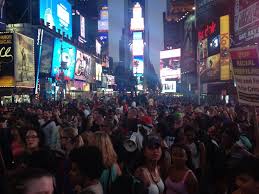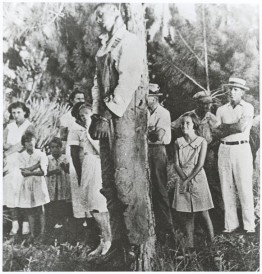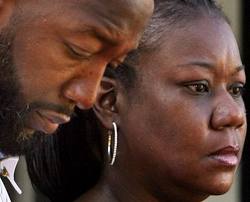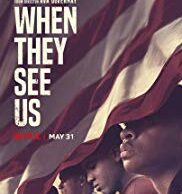No Justice for Trayvon: White Women in the Jury Box
During the trial of George Zimmerman for the murder of Trayvon Martin, considerable media coverage surrounded the selection of six women for jury duty. Perhaps, some speculated, an all-woman jury would be more sympathetic to the Martin family, recognizing the profound loss of a dead child. Or perhaps women are the “fairer” sex and would be able to more humanely deliberate about the details of the case. Or perhaps selecting six women might compensate for the glaring absence of any Black jury members.
B51 was once a real estate agent in Atlanta, and she ran a call center with 1,200 employees in Brevard County, Florida. Described as an older white woman, B51 has a dog and a cat. She told the court that though she knows a bit about the case, she’s not “rigid in [her] thinking.”*

Of course, we now know that none of these gendered speculations mattered: a jury of six women, five of them white and none of them Black, found Zimmerman not guilty, sparking national outrage and protests. Seemingly unaware of the furor invoked by the decision, Juror B-37—who wished to remain anonymous but nonetheless conducted a public interview and signed (then canceled) a book deal—stated, “All of us thought race did not play a role.” This was the same juror who, during jury selection, referred to Trayvon Martin as a “boy of color” whose murder was “an unfortunate incident.”
Of course, while enjoying the fruits of white privilege, this juror—like so many white people—likely doesn’t see herself as a racist. This is how invisible ideologies work. So let’s talk about racism, and specifically the historical, systemic racism of white women.
B76 has a 28-year-old son who is an attorney in Seminole County. The white, middle-aged woman also has a daughter who is 26-years-old. She didn’t know much about the Zimmerman case, but told attorneys that the defendant “had an altercation with a young man” and during the struggle, the gun went off. Though she doesn’t work currently, she used to work for her husband’s construction company. They’ve been married for 30 years.
 One of the most widely circulated photographs of lynching in America shows the murder by hanging of Rubin Stacy in (no surprises here) Fort Lauderdale, Florida. Stacy was falsely accused and lynched for the “crime” of harming a white woman, Marion Jones. In the photograph, Stacy’s lifeless body, clad in overalls and with bound hands, hangs from a tree—“strange fruit”—while a crowd of white people looks on. A man in a straw hat stands with his arms crossed, a woman behind the tree appears to be inching closer to Stacy’s body to gaze curiously, and a young girl in the foreground…smiles. Yes, smiles.
One of the most widely circulated photographs of lynching in America shows the murder by hanging of Rubin Stacy in (no surprises here) Fort Lauderdale, Florida. Stacy was falsely accused and lynched for the “crime” of harming a white woman, Marion Jones. In the photograph, Stacy’s lifeless body, clad in overalls and with bound hands, hangs from a tree—“strange fruit”—while a crowd of white people looks on. A man in a straw hat stands with his arms crossed, a woman behind the tree appears to be inching closer to Stacy’s body to gaze curiously, and a young girl in the foreground…smiles. Yes, smiles.
On the young girl in the photo, we see the “angelic” visage of a racist childhood, the seeds of white supremacy defined as outdoor adventure. Historian Amy Louise Wood, in Lynching and Spectacle, writes, “The cultural power of lynching—indeed, the cultural power of white supremacy itself—rested on spectacle: the crowds, the rituals and performances, and their sensational representations in narratives, photographs, and films.” Lynching lies at the historical intersection and construction of white supremacy, white southern womanhood, and white and black masculinity, the latter framed always as pathological in direct relation to the “purity” of white womanhood. As Wood also notes, “Lynching was thus more than a white prerogative; it was a patriarchal duty through which white men restored their masculine dominance.”
B37 is described as a middle-aged white woman who owns many pets. She worked for a chiropractor for 16 years and has two children – a 24-year-old dog groomer and a 27-year-old who attends the University of Central Florida. Both are girls. Her husband has a concealed weapons permit, and while she used to have one, she let it expire.
You might ask: What does lynching have to do with the George Zimmerman trial? Quite a lot, actually. Just as lynching was a potent and effective racial technology fostering white supremacy, so too is the American justice system a racial technology for fostering white supremacy, as Angela Y. Davis, Ruth Wilson Gilmore, and others have argued. In the land of the free, we disproportionately imprison people of color, and specifically Black men; African Americans make up almost half of all people imprisoned and are incarcerated at almost six times the rate of whites. And racial bias permeates every level of the criminal justice system, from racial profiling, to “stand your ground” laws, to arrests, to trials, to sentencing, to imprisonment, to the death penalty.
With patterns like these, is it any wonder that Black boys (and increasingly Black girls) are criminalized almost from birth? Regardless of the verdict, the facts in the Zimmerman case are clear (at least to many, if not the misguided jurors): George Zimmerman stalked and killed Trayon Martin—a boy out shopping for Skittles—because he had already racially profiled him. From the transcript of Zimmerman’s call to the police, his responses to the dispatcher’s anodyne questions reveal criminalization of Martin on the basis of race:
“He looks black”
“a dark hoodie, like a grey hoodie”
“…looking at all the houses”
“Now he’s just staring at me”
“He’s got his hand in his waistband. And he’s a black male”
“Something’s wrong with him. Yup, he’s coming to check me out, he’s got something in his hands”
“These assholes always get away”
Race, gender, and criminality, all woven into one “suspicious” package: a young, unarmed Black boy carrying a bag of candy.
Sanford, Florida, where the racial profiling and murder of Trayvon Martin occurred, has its own foul racist history. From 1882 to 1930, Florida had the highest number of lynchings per capita in the nation, and three lynchings occurred in the 1940s, one as late as 1943. In 1946, baseball legend Jackie Robinson was greeted in Sanford with Jim Crow segregation and the KKK. In his autobiography, Robinson described his horror at the level of racism directed toward him and his new wife, Rachel, from local whites—painful experiences that led him to a lifetime of social justice work.
The Hispanic nurse serving on the jury didn’t even live in Sanford at the time of the shooting –she was residing in Chicago with her several children and husband. She also hates watching the news, telling the court during pretrial publicity questioning that she really loves her reality television shows (like Bad Girls Club).
Much has been written about negative representations of Trayvon Martin during the trial as a “thug,” and the insidious ways in which he was further criminalized by the very system meant to adjudicate his death. And defense attorneys O’Mara and West repeatedly emphasized why Martin was “suspect,” implicitly connecting him to other crimes. Much has also been written about the ways the trial is—despite the self-serving claims of certain jurors and the defense team—very much about race in America, including the absurd white supremacist fantasy that we live in a “post racial” nation. And there is predictable, considerable handwringing on many fronts about whether the nation can “heal” after this trial and its misguided verdict. But much less has been written about race, gender, and the six jurors, five of them white women.
It is striking that in her post-verdict interview, juror B-37–from whom four of the other jurors distanced themselves in a statement on July 16– revealed that she sympathized with both Zimmerman and Trayvon Martin. She stated, “I feel sorry for both of them. I feel sorry for Trayvon, in the situation he was in. I feel sorry for George because of the situation he got himself in.” The same juror confided, “Both were responsible for the situation they had gotten themselves into.” She believes that Zimmerman has learned an important lesson, and she feels he can safely go back to community policing: “I think he just didn’t know when to stop. He was frustrated, and things just got out of hand.” And by “things just got out of hand,” surely she must have meant, “George Zimmerman shot and killed an unarmed child.”
E40 may have a different kind of perspective on the Zimmerman case. She describes herself as a “safety officer” who is well versed in cell phone technology. Described as a white woman in her 60s, E40 loves football and is married to a chemical engineer. Her 28-year-old son is out of work.
 In what system of logic does juror B-37’s statement even make sense? In the “logic” of white racism, and specifically white female racism, it is all too easy for white women to identify with anyone (in this case, George Zimmerman) who was “no doubt,” according to the juror, fearing for his life because he was being followed by a predacious Black criminal. I would suggest that the only way this verdict makes even a modicum of sense is that the non-Black women jurors—five white and one Hispanic—rather than seeing Trayvon Martin as somebody’s child, as the son of Tracy Martin and Sybrina Fulton, as a child buying candy, as just another teenage boy, saw him instead as a thug. And nothing in the Prosecution’s clumsily argued case dispelled white jurors’ fundamental cultural presumption of Black criminality.
In what system of logic does juror B-37’s statement even make sense? In the “logic” of white racism, and specifically white female racism, it is all too easy for white women to identify with anyone (in this case, George Zimmerman) who was “no doubt,” according to the juror, fearing for his life because he was being followed by a predacious Black criminal. I would suggest that the only way this verdict makes even a modicum of sense is that the non-Black women jurors—five white and one Hispanic—rather than seeing Trayvon Martin as somebody’s child, as the son of Tracy Martin and Sybrina Fulton, as a child buying candy, as just another teenage boy, saw him instead as a thug. And nothing in the Prosecution’s clumsily argued case dispelled white jurors’ fundamental cultural presumption of Black criminality.
The interview with juror B-37 is revealing here, too. She was clearly persuaded by the defense team’s portrayal of Martin as suspicious, in her words “cutting through the back, looking into houses…it was late at night, dark at night, raining.” Where Trayvon Martin’s friend Rachel Jeantel described him as a young man out alone at night, afraid of the man (Zimmerman) following him, clearly the white women jurors did not see this particular Trayvon Martin. They did not see a vulnerable teenager, alone at night walking through a neighborhood with a possible sexual predator on his trail. No, what they saw—and what juror B-37 clearly described seeing—was a “thug” up to no good, as responsible for his own murder as his killer. So pervasive is racism that juror B-37 could describe George Zimmerman as “a man whose heart was in the right place, but just got displaced by the vandalism in the neighborhoods, and wanting to catch these people so badly that he went above and beyond what he really should have done” (my emphasis).
Right, because Zimmerman should not have followed Trayvon Martin, nor should he have killed the unarmed youth. Here, we see a representation of George Zimmerman as the (armed) Good Guy, whose apparent decency was led astray by persistent Black criminality (e.g., “the vandalism in the neighborhood”).
When E6 learned about the Zimmerman case, she used it as an example for her two adolescent children, warning them not to go out at night. She is married to an engineer who owns guns and has lived in Seminole County for eight years.
I had a telling encounter with a friend the other day, a white woman who is a mother to three children and a proverbial pillar of the community. When I expressed my feelings about the Zimmerman verdict—that it was wrong on many levels—in the assumption that she would agree with me, her facial expression immediately told me I was mistaken. She responded with the statement, “We need to trust the justice system,” noting that “this was a case we never should have known about…it was blown up by the media and it never even should have come to trial.” I was most struck by the “we” in her words, because clearly “we” had starkly different feelings about the trial and whether any sort of justice was served. The term “we” is one of inclusion as often as it is of exclusion, and I wanted no part of it.
 Critics and detractors of my argument—and I suspect there will be many who will claim that I’m manufacturing racism where there was simply not enough reasonable doubt to convict—will likely point out that I have no way of knowing whether these six jurors are, in fact, racist. As if racism is only an internal belief system that does not manifest itself in life’s decisions and actions, including jury deliberations. Was the little white girl in the Rubin Stacy lynching photograph “really” racist? Were the white women jurors in the George Zimmerman trial “really” racist? In some ways, it doesn’t matter, because their very presence as white girls and women is already unequivocally implicated in the machinations of white supremacy. Indeed, the architecture of white supremacy is crafted from the bricks and mortar of racism and patriarchy.
Critics and detractors of my argument—and I suspect there will be many who will claim that I’m manufacturing racism where there was simply not enough reasonable doubt to convict—will likely point out that I have no way of knowing whether these six jurors are, in fact, racist. As if racism is only an internal belief system that does not manifest itself in life’s decisions and actions, including jury deliberations. Was the little white girl in the Rubin Stacy lynching photograph “really” racist? Were the white women jurors in the George Zimmerman trial “really” racist? In some ways, it doesn’t matter, because their very presence as white girls and women is already unequivocally implicated in the machinations of white supremacy. Indeed, the architecture of white supremacy is crafted from the bricks and mortar of racism and patriarchy.
The Zimmerman trial has demonstrated viscerally that the knot of racism, white womanhood, Black male pathology, and “justice” is cinched as tightly as ever in our “post racial” century. And Black bodies—even when they are the victims, as Trayvon Martin was—are still criminalized.
*Italicized juror bios are all taken verbatim from Global Grind.




Pingback: Statement by 2012-2013 Executive Committee on the Verdict of George Zimmerman | The WINsight
Pingback: Statement by 2012-2013 Executive Committee on the Verdict of George Zimmerman | The WINsight
Pingback: Statement by 2012-2013 Executive Committee on the Verdict of George Zimmerman | The WINsight
Pingback: Statement by 2012-2013 Executive Committee on the Verdict of George Zimmerman | The WINsight